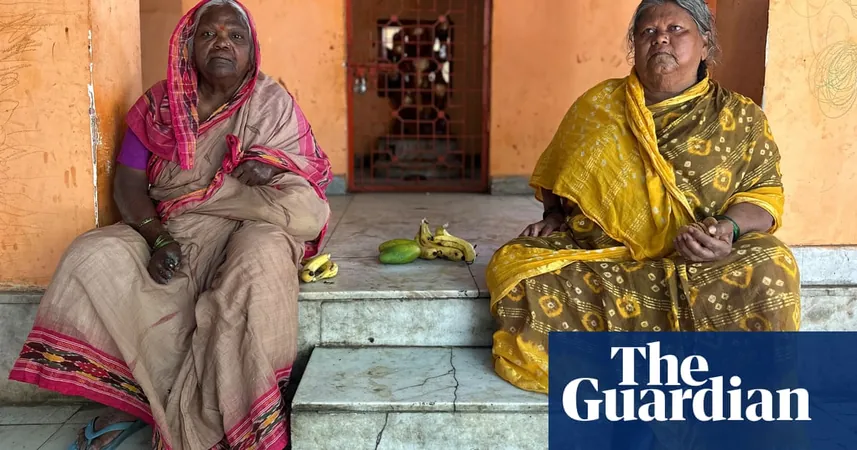
Experts Skeptical of India's Ambitious Leprosy Elimination Goal by 2027—Is It Just a Smoke Screen?
2024-09-30
Author: Arjun
Experts Skeptical of India's Ambitious Leprosy Elimination Goal by 2027—Is It Just a Smoke Screen?
In a heart-wrenching account, Tanu Bai, who lost her family at a young age, recalls the debilitating effects of leprosy that left her unable to feel burns or wounds on her hands and feet. Orphaned at 10, she faced rejection from her community and found refuge at the Satya Jeevan Leprosy Society in Delhi, one of approximately 800 leper colonies still operational in India today. Now in her sixties, Bai reflects on her life at the colony, where companionship provides solace despite the harsh realities of living with leprosy, including the extreme heat of Delhi summers.
Leprosy, also known as Hansen’s disease, remains a significant public health concern in India, which accounts for about 60% of the more than 200,000 new cases reported annually worldwide. In January 2023, the Indian government launched the "Leprosy Mukt Bharat" campaign, pledging to eradicate the disease by 2027—three years ahead of the World Health Organization's goal. However, many experts are skeptical about the feasibility of this target.
Maya Ranavare, president of the Association of People Affected by Leprosy (APAL), criticized the initiative as mere political posturing. "This push to eliminate leprosy is more about optics than reality," she states, suggesting that the underreporting of cases is a part of a broader trend where public health decisions are made for political gain rather than patient welfare.
The disease, caused by the bacterium Mycobacterium leprae, affects not only the skin but also peripheral nerves and can lead to blindness if untreated. Historically considered highly contagious, it is now understood that leprosy requires close and frequent contact with an infected individual for transmission, and when caught early, it is curable.
Despite a significant decline in global leprosy cases since the introduction of multidrug therapy in the 1980s, India's progress has stagnated following a milestone in 2005 when the country declared its leprosy elimination. As funding for leprosy-specific programs diminished, the government scaled back its search for cases, mistakenly believing that the healthcare system could effectively handle what remained.
Ritul Choudhary, a dermatologist at RML Hospital in Delhi, echoes concerns about public awareness, saying, "Many of my patients have never even heard of leprosy before their diagnosis." He points out that education around diseases like HIV and tuberculosis far surpasses that of leprosy, which remains largely misunderstood.
Prasant Naik, head of Lepra Society India, laments the decline in public education efforts about leprosy, stating that awareness initiatives once supported by Bollywood and other media have fizzled out. "Everything has fallen through the cracks," he explains, highlighting that medical education has not kept pace, leaving new doctors ill-equipped to recognize and treat the disease.
Experts like Vishwa Katoch, a former high-ranking health official, urge for a renewed focus on vaccination, recommending the consideration of the MIP vaccine—albeit with limited effectiveness at just 60%. However, previous plans for a vaccine rollout were derailed due to the COVID-19 pandemic.
With 2027 looming, skepticism grows over whether India can fulfill its ambitious target. Critics fear that the government might downplay actual case numbers to project the illusion of success. Mohan Arikonda from APAL corroborates, "There's pressure on medical officers to hide cases," highlighting a culture of denial that could harm vulnerable communities.
While Naik acknowledges that ambitious targets may help to garner international funding—something India lost after its earlier success—he remains doubtful about actually eradicating leprosy by 2027. The recent trend of compressing resources could lead to more significant issues down the line unless drastic changes occur at the grassroots level.
As India propels itself toward this ambitious goal, the question lingers: will reality align with rhetoric, or will it be just another chapter in the long and complex history of leprosy in the country? With dependency on systemic changes and genuine commitment, the fight against leprosy in India is far from over.



 Brasil (PT)
Brasil (PT)
 Canada (EN)
Canada (EN)
 Chile (ES)
Chile (ES)
 España (ES)
España (ES)
 France (FR)
France (FR)
 Hong Kong (EN)
Hong Kong (EN)
 Italia (IT)
Italia (IT)
 日本 (JA)
日本 (JA)
 Magyarország (HU)
Magyarország (HU)
 Norge (NO)
Norge (NO)
 Polska (PL)
Polska (PL)
 Schweiz (DE)
Schweiz (DE)
 Singapore (EN)
Singapore (EN)
 Sverige (SV)
Sverige (SV)
 Suomi (FI)
Suomi (FI)
 Türkiye (TR)
Türkiye (TR)